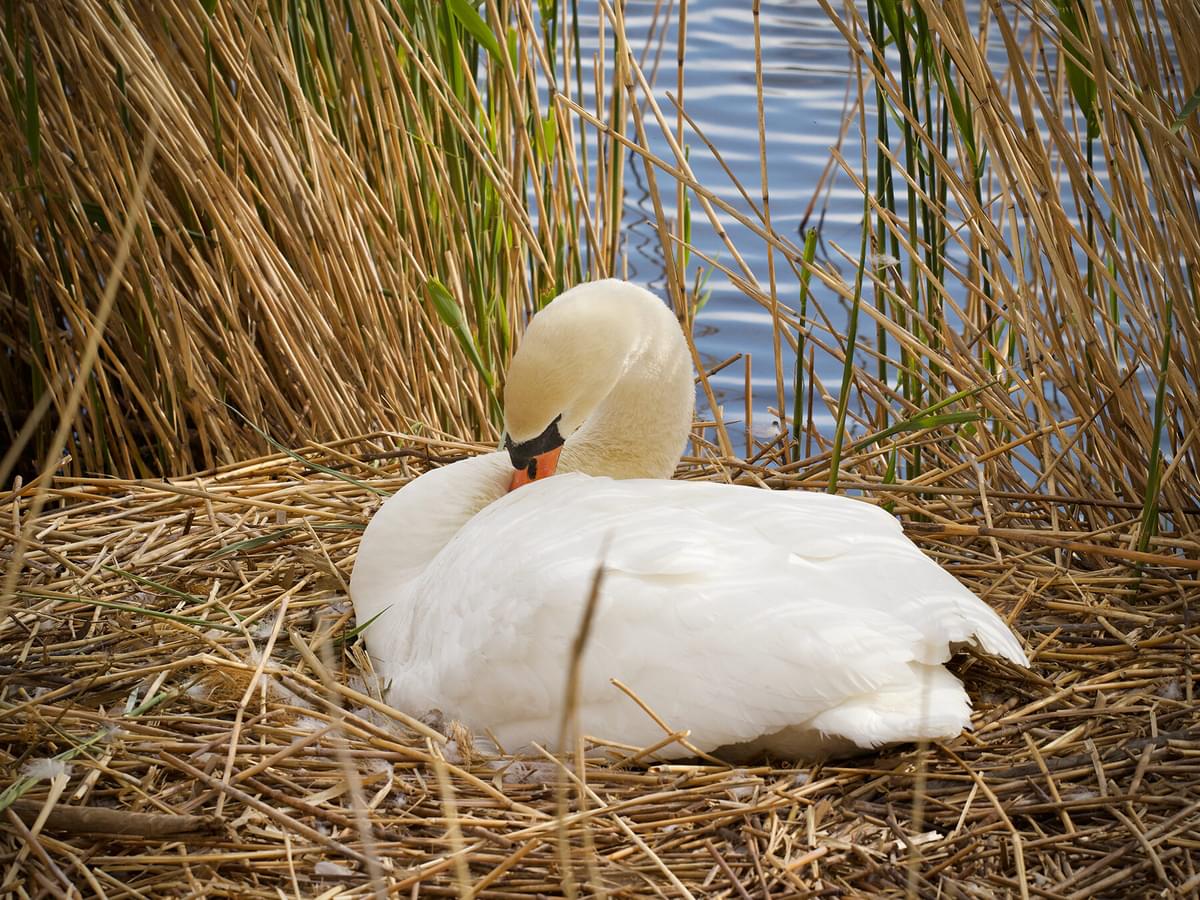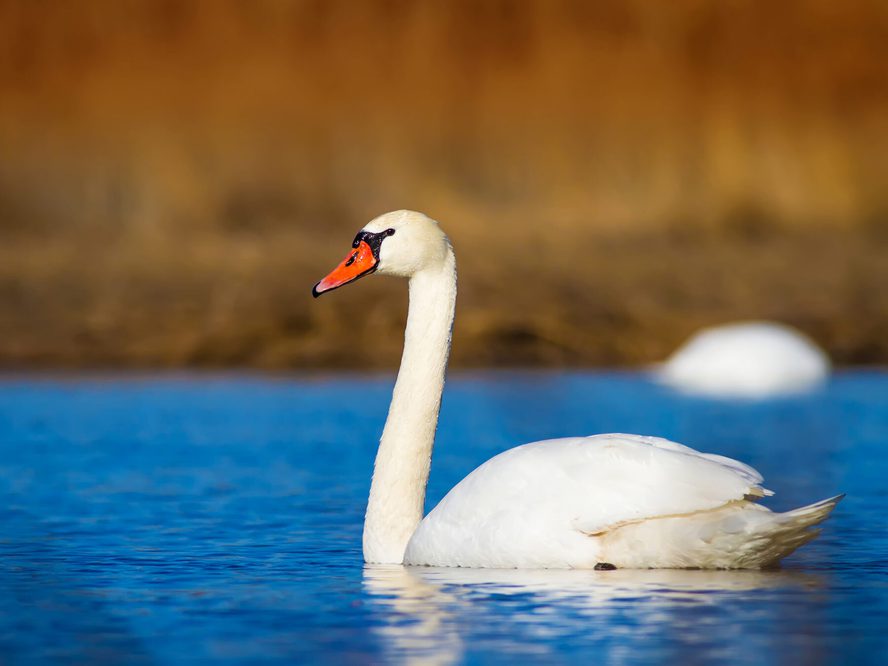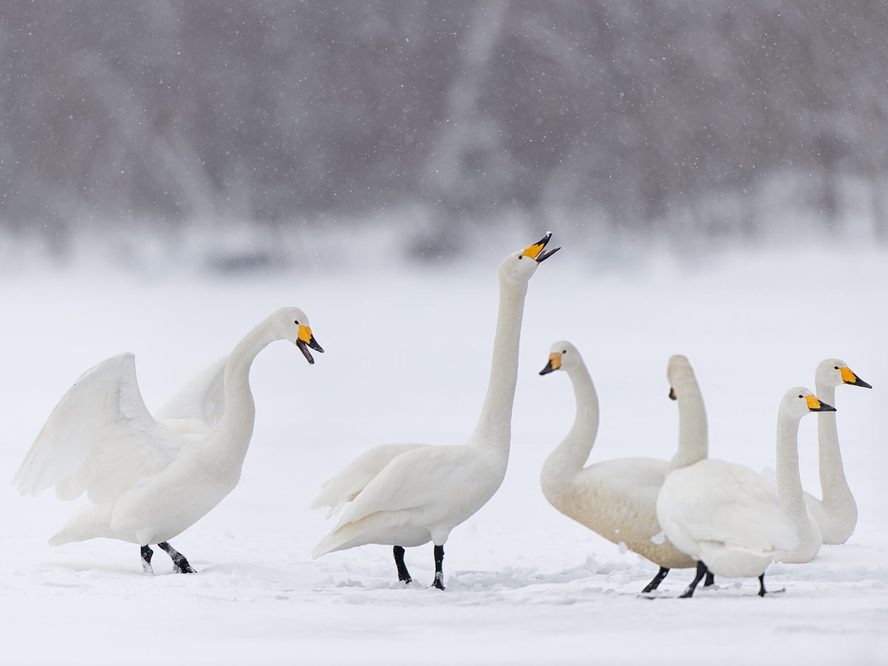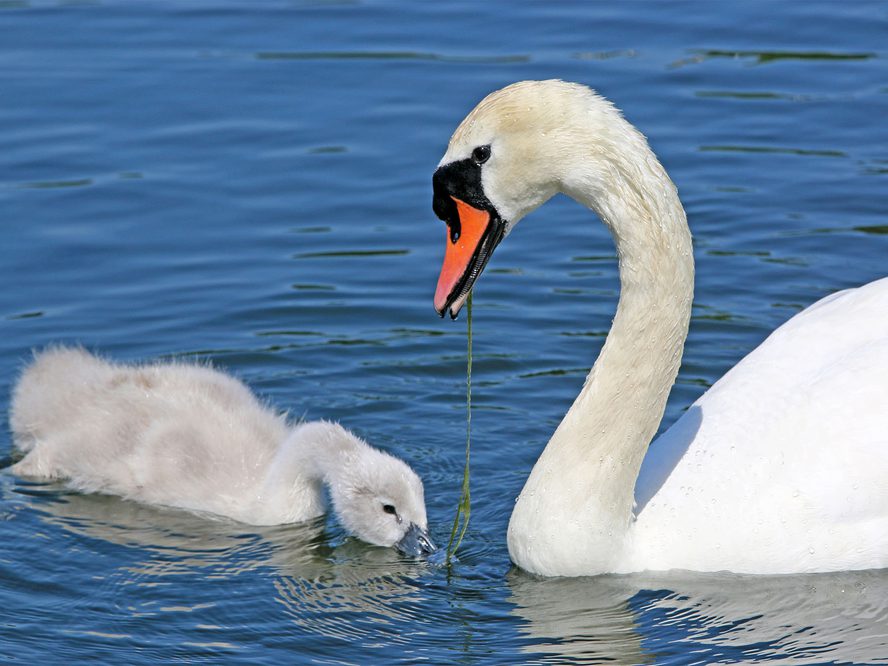Jump to Section
Swan Nesting (Complete Guide)
Last updated: 2 February 2023

Swans are the kings and queens of the waterway, and they wear their resplendent white plumage proudly (or black in the case of the Black swan!). There are only six species of swans, but they inhabit every continent apart from Africa and Antarctica. Here, we’ll be taking an in-depth look at swan nesting.
Swan nests are typically built close to the shores of lakes and rivers where the water is calm or still if possible. There is no ‘small’ species of swan, and as large birds, swans build impressively large nests; the nests of Mute, Whooper, or Trumpeter swans can reach diameters of some 3.5m!
By maintaining a reasonable distance from the shore, swans try to keep their nests away from mammalian predators, but this isn’t always possible.
The nests are built from various materials, including twigs and branches, bulrushes, reeds, and other aquatic vegetation. Swans are very methodical in their nest-building - some ornithologists and birdwatchers have described it as meditative or ritualistic.
The strength of their pair bond shines through during nest building, as while both the male and the female take on slightly different roles, there is often a sense of real synchrony about how they go about their work. For swans, the love and craft that goes into the nest is just another piece of their beauty
Read on to discover more about the nesting behaviours of these wonderful birds!
| Key Swan Nesting Facts | |
|---|---|
| Nesting season | March to July |
| Nesting material | Twigs and branches, bulrushes, reeds, and other aquatic vegetation |
| Nest type | Large, circular mound |
| Nest location | Usually close to the shore, in shallow water |
| Number of broods | One |
| Clutch size | 4 - 10 eggs |
| Egg colour | White with a rough texture, some species pale blue |
| Egg size (Mute Swan) | 10 - 12.6 cm (4 to 5in) x 6 - 8 cm (2.4 to 3.2in) |
| Egg weight (Mute Swan) | 340 g |
| Incubation period | 34 - 44 days, mainly by the female |
| Fledgling period | Immediately, but first flight fledge is usually 120 – 150 days after hatching |
| Reuse nests | Yes |
| Use nest boxes | Will use floating nest platforms |

A family of swans on their nest
Where do swans nest?
Swan nests are nearly always placed close to the shore in relatively shallow, calm or still water. Any obstructive reed beds or vegetation are a bonus and help camouflage the nest from land predators while also providing a steady supply of building materials.
Swans generally prefer the wider, calmer lower course of a river to the choppier upper and middle courses, and also nest in lakes and ponds. Most nests are built within a few metres of the shore, but some Mute swan nests are found around 25m away from dry land and floated in deeper waters.
The male typically chooses the nesting site, but the female might refuse or reject several of his choices before accepting one. Interestingly, pairs of Mute swans often return to where the female was born to nest. Pairs of swans usually occupy a stretch of water on their own and isolate themselves from other pairs to avoid fights and conflicts.
Swans occasionally nest on dry land, particularly if there’s an available island inaccessible to land predators.

A female mute swan (Cygnus olor) sitting on eggs in her nest on a lake in southeast England
What do swan nests look like?
Swan nests are large, circular mounds built from an array of twigs, branches and other selected vegetation. Amongst the six species of swans, all of their nests look similar and are built in broadly the same way. Some are floated in the water, while others are built in shallow, marshy reed beds.
Large and circular with a nest-like depression in the middle, swan nests are pretty unmistakable.

The nest of a swan with five eggs inside
How big are swan nests?
Swan nests are nearly always bigger than 1 metre in diameter, and some range up to 3.5m. They can protrude some 30cm to 60cm from the surface of the water and are hard to miss if you’re lucky enough to walk past one.
Many swan nests are maintained continually throughout the breeding season, and so they tend to increase in size. Furthermore, many pairs of swans reuse the same nest - especially if they raise a successful brood there - which means that nests might continue to grow in size year after year.
What time of year do swans nest?
In much of the Northern Hemisphere, the swan breeding season ranges between March and July. If the first brood fails, swans may attempt to raise another brood, but this depends on how early in the season the brood is lost.
The incubation period is quite long too (35-41 days), which means swans can easily run out of time to re-nest, especially if the first nest is destroyed.
Swans maintain their nests throughout the breeding season and often return to the same nest each year, but they only actively use the nest while raising the chicks for the first week or so after hatching.

Black Swan nest
How do swans build their nests?
In all species of swans, both the male and the female work together to build the nest. However, the male often initiates the building process and collects the materials as the female assembles the nest. This does vary, though; the female does also help accumulate materials.
Once materials are gathered at the nesting site, the female typically places the material in a disc-shaped mound using forward and sideways movements. The movements themselves seem well-coordinated and ritualistic.
After the swans accumulate a mound of material, the female will sit in the middle and compact the middle with her body and feet. The male will continue to place materials around the female, which continues through incubation.
Nests take around ten days to finish in their entirety but can be finished in just 4 to 5 days if needs be.

Mute Swan collecting materials to construct the nest
When do baby swans leave the nest?
Baby swans are able to walk and leave the nest within a few days of hatching, but they stay close to their parents for around 4 to 5 months, or even longer.
It’s not uncommon for juvenile swans to stay close to their parents for most of the year before joining a flock of their own.
How many broods do swans have?
Swans generally only have one brood. They lay a relatively large clutch of 4 to 10 eggs with the expectation of losing some. Cygnet mortality rates are around 50%, so it’s likely that around half of any brood will die.
If the entire brood or nest fails, swans will usually choose to renest and lay another brood, but this does depend on how late or early it is in the season, weather conditions, etc. For example, if the entire nest is lost to adverse weather conditions and flooding then it may not be possible to renest. Few wild swans will raise a successful brood every year.

The moss nest of a Whooper Swan
Do swans nest in the same place every year?
All species of swans may return to the same nesting site every year, or possibly even the same exact nest. They’ll aim to replenish and rebuild the nest if possible.
This is particularly true if the parents successfully raise a healthy brood at the site. Also, swans are highly territorial, and once they’ve established their nesting site, they’re unlikely to let go of it easily - they will not nest in another nest other than their own.
Of course, the exception is when the nest is destroyed or when the nesting site is no longer viable, e.g. it’s been flooded. In this case, swans will choose another nesting site nearby.
What do swan eggs look like?
Swan eggs are very large, measuring around 10 to 12.6 cm long (4 to 5in) and 6 to 8 cm wide (2.4 to 3.2in), in the case of the Mute swan.
Whooper and Trumpeter swan eggs are similarly sized, whereas Tundra, Black-necked and Black swan eggs are slightly smaller.
The eggs are generally white with a rough-ish texture. However, some eggs are bluish-grey, particularly in the case of the Black swan.

A family of Mute swans at the nest
What month do swans lay eggs?
In most of Europe and North America, swan eggs are laid in the traditional spring breeding season, between the months of Mid-March and April and July.
In Australia, the Black swan breeding season is different, spanning March all the way through until September, but some may breed in the winter. The traditional spring breeding season typically applies to the Northern Hemisphere only.
Do swans use nest boxes?
Swans won’t use nesting boxes, but they will use floating nest platforms. Floating nest platforms are semi-waterproof, stable and resilient to weather damage and flooding, and they significantly improve swans’ chances of raising successful broods.
One man in St. Ives watched a pair of swans repeatedly fail to raise a brood for some ten years and chose to build them a floating raft. After transferring the nest to the platform, the pair successfully hatched no fewer than eight cygnets!

A swan sleeping on the nest
Where do swans nest at night?
Swans only sleep on the nest at night during incubation. Once the chicks hatch, they’re able to swim within just two to three days and will join their parents on the water and on land. Swans either sleep on the land or in water, depending on the location, presence of predators, etc.
Do swans nest in gardens?
Swans will certainly nest in gardens if they contain a suitable waterside habitat.
Swans are often kept on the grounds of castles and stately homes, such as Leeds Castle, which is home to Mute, Trumpeter, Whooper and Black swans. Since swan nest failure is high in the wild, swanneries and swan sanctuaries provide a safe area for these birds to breed.
On this page
- Where do swans nest?
- What do swan nests look like?
- How big are swan nests?
- What time of year do swans nest?
- How do swans build their nests?
- When do baby swans leave the nest?
- How many broods do swans have?
- Do swans nest in the same place every year?
- What do swan eggs look like?
- What month do swans lay eggs?
- Do swans use nest boxes?
- Where do swans nest at night?
- Do swans nest in gardens?







